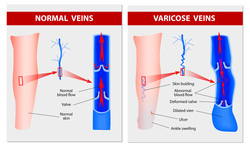Leg Vein Treatment: Brisbane
As Brisbane’s leading vein clinic, we provide a range of options for the treatment of leg veins including:
- Varicose Veins Surgery
- Endovenous Laser Treatment
- Varicose Vein Treatments
- Varicose Veins Surgery
- Sclerotherapy
Diagnosing Leg Veins
Varicose
veins are dilated, stretched leg veins that are visible just under the surface
of the skin. In the legs, varicose veins are associated with the following
symptoms:
- Ankle swelling
- Discomfort
- Night cramps
- Restless legs
- Cometic Deficiency
What are Varicose Veins?
Varicose veins are the blood vessels that carry blood from the peripheries back towards the heart. While arteries carry blood from the heart out to the peripheries, varicose veins carry blood from the peripheries back to the heart.
Veins have one-way valves that keep the blood flowing towards the heart. If valves become weak or damaged, then pressure is transmitted back towards the peripheries and the varicose veins then can stretch both in diameter and in length.
Veins have one-way valves that keep the blood flowing towards the heart. If valves become weak or damaged, then pressure is transmitted back towards the peripheries and the varicose veins then can stretch both in diameter and in length.
Varicose Vein Risks
There are many factors that can raise the risk of developing varicose veins and some of these include family history, advancing age, female gender, pregnancy and obesity.
Problems with varicose veins can occur in up to 50% of men and 60% of women. Varicose veins can be associated with superficial thrombophlebitis and this itself may lead to deep venous thrombosis.
Problems with varicose veins can occur in up to 50% of men and 60% of women. Varicose veins can be associated with superficial thrombophlebitis and this itself may lead to deep venous thrombosis.
Varicose Vein Surgery
There are a number of options available from a leg vein surgeon for those looking for varicose vein treatment. Including:
- Varicose Veins Surgery
For more information about how we can treat your leg veins, click the button below.
- Endovenous Laser Treatment
- Varicose Vein Treatment
- Varicose Veins Surgery
- Sclerotherapy
For more information about how we can treat your leg veins, click the button below.
Varicose Veins of the Legs
|
Varicose veins are dilated, stretched veins that are visible just under the surface of the skin. Although these vessels usually occur in the leg, they can appear in other parts of the body. In particular, they can be hidden inside the pelvis. Varicose veins are common. In the legs they are associated with symptoms such as ankle swelling, discomfort, night cramps, restless legs and cosmetic deficiency. In the pelvis, varicose veins can be associated with bladder urgency, nocturia and chronic pelvic pain with lower back pain.
Varicose veins are the blood vessels that carry blood from the peripheries back towards the heart. While arteries carry blood from the heart out to the peripheries, varicose veins carry blood from the peripheries back to the heart. The circulation system consists of the heart which is a muscular pump, where the arteries take blood out to the peripheries. The capillaries are where oxygen transfer takes place in the veins which bring blood back from the peripheries to the heart and then to the lungs where the oxygen content of the blood is replenished. Veins have one-way valves that keep the blood flowing towards the heart. If valves become weak or damaged, then pressure is transmitted back towards the peripheries and the varicose veins then can stretch both in diameter and in length. There are many factors that can raise the risk of developing varicose veins and some of these include family history, advancing age, female gender, pregnancy and obesity. Problems with varicose veins can occur in up to 50% of men and 60% of women. Varicose veins can be associated with superficial thrombophlebitis and this itself may lead to deep venous thrombosis. |
On the left is a normal vein, with valves ensuring that the flow of blood is upwards towards the heart
On the right, the valves are not functioning normally. Blood is flowing back towards the foot, distending the veins in the lower leg. Book a Consultation
|

